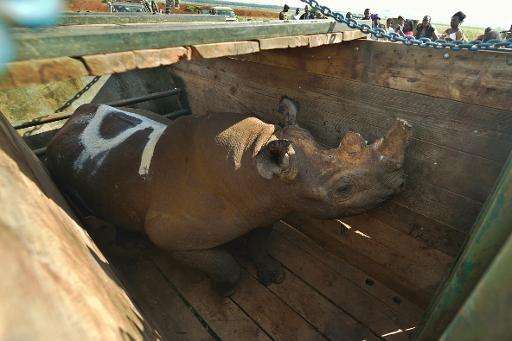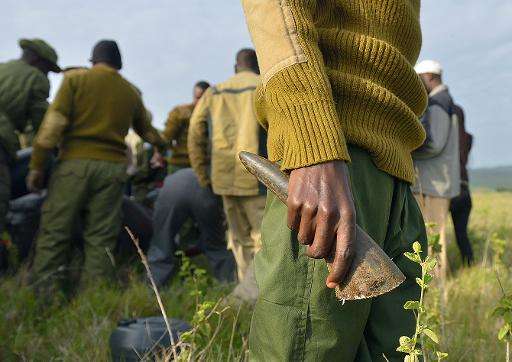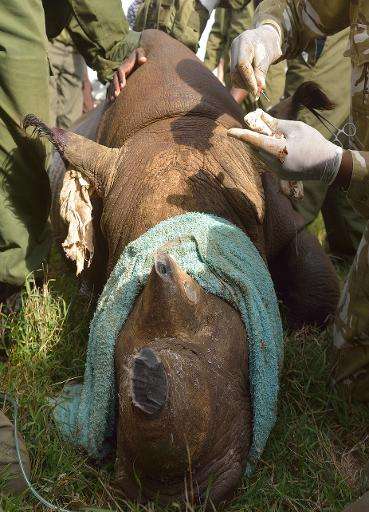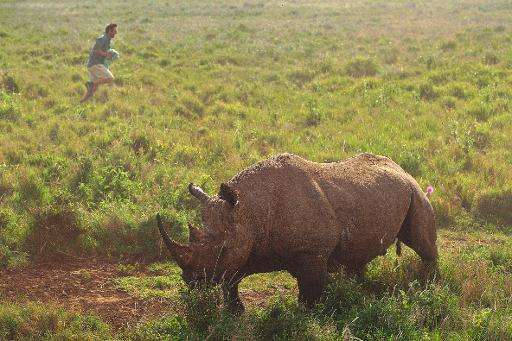Rare black rhinos find new sanctuary in northern Kenya

Nasha was first to go down, a red-feathered dart sticking out of his thick-skinned rump. Next it was Syrah's turn as Matthew Mutinda, a vet, fired his tranquillizer gun from a low-hovering helicopter.
Minutes later the one-tonne rhinoceros crashed headfirst into the ground in a cloud of dust.
Frantic activity followed. Batian Craig, a conservationist specialising in wildlife security, revved up a chainsaw and sliced off the rhino's horn. Then he drilled into the remaining stump and stuck a radio transmitter in the hole. An oxygen tube was inserted up the rhino's snout, blood samples were taken and cooling water poured over his back. Nasha's breaths were deep and steady. His skin felt like a hot, damp carpet.
The darting of Nasha, 14, and Syrah, 10, was the culmination of years of efforts to establish a new rhino sanctuary in northern Kenya, the first on land owned by a local community rather than in a government park or private reserve, and in a place that stopped being home to rhinos when poachers killed the last one decades ago.
"The euphoria of that first rhino track on the ground after 30 years? You can't put it into words," said Ian Craig, conservation director at the Northern Rangelands Trust (NRT) and architect of the rhino relocation from Lewa Wildlife Conservancy to Sera Conservancy Trust.
For Reuben Lendira, Sera's manager and the man ultimately responsible for the safety of the 21 black rhinos that will live on 10,700 hectares (26,000 acres) of fenced wilderness, the animals are a means to an end. "It creates job opportunities and improves security," said Lendira.
Darted, crated, trucked
"Sera was a prone area for bandits, so since we established security it has really improved, for both wildlife and people. It will also improve income because we can get more tourists and that will improve life for the community around Sera," he said.
Sera is among 33 community conservancies set up by NRT. Its 59 rangers patrol the rhino sanctuary, the wider 345,000-hectare (853,000-acre) conservancy of which it is a part and the area beyond, where the rangers have police reservist status allowing them to carry weapons and arrest criminal suspects, whether poachers, cattle rustlers or thieves.
For Nasha and Syrah the day began like any other with a tussle over territory that left both animals bloodied and torn. Then the helicopter appeared over the acacia trees with Mutinda, the Kenya Wildlife Service vet, strapped in and leaning out, dart gun in his hands.
After being shot Nasha charged about. The long savannah grass, fed by weeks of drought-breaking rain, brushed against his belly as he ran.

Pilot Mike Watson, Lewa's chief executive, lowered the aircraft close to the ground and manoeuvred it like a matador in a bullring to direct the rhino to a flat, open area where a truck-mounted crane could be parked and a fortified wooden crate lowered to the ground.
Nasha slackened then keeled over. "By the third minute you can see the animal high-stepping and by around the seventh minute it goes down," Mutinda said afterwards.
The dehorning, installation of the radio transmitter and taking of samples took little more than 20 minutes. Mutinda woke the rhino up again with an antidote injected behind the ear, a slap to the jaw and a jab from a cattle prod that made Nasha lurch forward into the crate positioned at his head.
In past captures, the impact of the heavy, fast-moving rhino hurling itself at the far end of the crate has sent rangers and photographers flying.
Each rhino was put into his own wooden box, strengthened with metal bracing, and loaded by crane onto the flatbed of a truck for the four-hour drive north to their new home.
Space for wildlife
This month's relocation of black rhinos is being hailed as proof of Kenya's success in breeding the critically endangered animals, and its commitment to securing space for them to roam.
There are around 5,000 black rhinos left on the planet and they are threatened by Asian demand for rhino horn, which has a market value of more than $65,000 (60,000 euros) a kilo. In 2011, the western black rhinoceros, a subspecies last seen in Cameroon, was declared extinct.
There are an estimated 20,000 white rhinos, mostly in southern Africa, but only five of the northern white subspecies, including just one male.

"Kenya's problem is not just poaching, it's space for wildlife. Kenya needs a new sanctuary like this every year," said Ian Craig.
Sera's sanctuary is big enough for 55 rhinos—the target population if the animals breed successfully—but despite the fence, keeping them safe is still a full-time job.
Rangers follow the rhinos wherever they go, keeping eyes on them constantly. The radio transmitters in their horns relay the animals' position to a control room at Lewa which is also manned 24 hours a day.
The cost of security is around $850 (780 euros) per rhino per month.
Nasha and Syrah, who bolted furiously from their crates when they were released, were to join a mixed-sex group of 21 breeding-age rhinos being moved to Sera from Lewa as well as from Kenyan national parks at Nakuru and Nairobi.

Relocating rhinos is not without risk, however: one rhino did not wake up after being tranquilised while two others died of dehydration days after reaching Sera. One was Syrah. As a result, Kenyan authorities suspended the operation after 13 of the animals were moved.
"It's massively upsetting to see a rhino die, it destroys you," said Craig. "We're in a Catch-22: there are always risks, but we have to move the rhinos if the populations are to grow."
The sadness of seeing three of the animals die has not blunted determination to find new sanctuaries to safeguard Kenya's black rhinos.
"The reality is that in the conservation world we live in crisis," said Craig.
© 2015 AFP



















